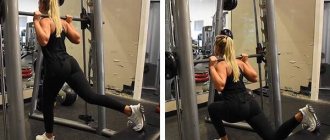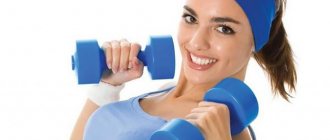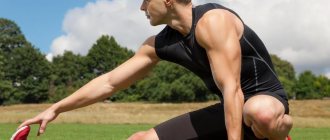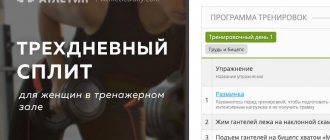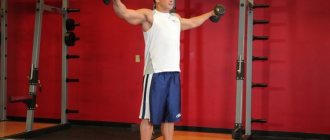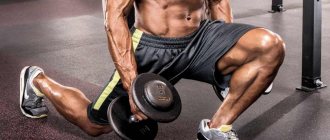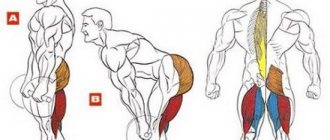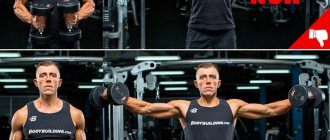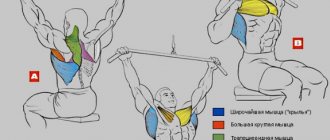Execution technique
- Take a pair of dumbbells (one in each hand) and place them at the sides of your body in front of you. Hold with an overhand grip (palms facing your feet). It is important that the torso is vertical, the arms are straight, and the shoulder blades are brought together and lowered down. This increases tension in the back and prevents unwanted rounding of the shoulders forward.
- Place your feet shoulder-width apart and bend your knees slightly to ensure a smooth descent of the weight. Make sure the dumbbells move (slide) vertically near the front of your thighs (don't let them move forward). To do this, move your pelvis back, but keep your back straight and your knees in line with your ankles. As a result, you will feel tension in the back of your thighs (biceps) and throughout your back (bottom and middle, and especially around the shoulder blades). Lower yourself down just below your knees until you feel a distinct stretch in your hamstrings. Pause at the bottom point for 1-2 seconds.
- After this, use your buttocks and thighs to push yourself upward. At the top of the movement, tighten your upper back, torso, and glutes.
- Inhale as you go down, and exhale as you go up.
- Complete the required number of repetitions.
Exercises
Now that you know how to choose the right loads, and that you will have to train hard, you can begin to consider the most effective solutions for pumping up the buttocks. The list of exercises is quite large, but this does not mean that all of them need to be performed in one day:
- dumbbell plie;
- squats with wide legs;
- deep squats;
- lunges;
- farmer's walk with long strides;
- deadlift (bending forward with dumbbells).
Let's look at how it works and how to do each of them correctly.
There is another exercise - this is the gluteal bridge. This is an extremely difficult exercise that requires a barbell or Smith bench. At the same time, its effectiveness is extremely low, and the slightest violation of the technique can have a very bad effect on the overall health.
Dumbbell plie
The dumbbell plie is the first basic dumbbell exercise for the buttocks and thighs. It almost completely disables the quadriceps from working. In this case, the entire emphasis shifts exclusively to the gluteal muscles. If your goal is exceptionally beautiful legs, thighs and firm buttocks, you won’t be able to do without it.
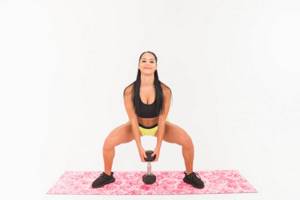
How to do it?
- Spread your legs as wide as possible.
- Socks point to the sides.
- Bend your back.
- The head looks straight ahead. If this is difficult, you can look up, but not down.
- Dumbbell – weighing up to 15 kg (for beginners, the optimal weight is 5-8 kg), located in the hands, between the legs.
- Squat down as deeply as possible, while maintaining an arch in your back.
- Fix at the lowest point for 1-2 seconds.
- Get up.
If you have a mirror, looking into it you should see movements very similar to how sumo wrestlers take the starting position before a match.
Wide Leg Squats
This exercise with dumbbells for the buttocks is more suitable for losing weight than for pumping up muscles. Despite its anaerobic nature, it involves all major muscle groups, due to which calorie content and energy consumption during the approach increase several times. All this leads to a calorie deficit and weight loss. From the point of view of using the buttocks, here, depending on the placement of the heels, the load may shift slightly to the front of the legs, which will allow them to be tightened, but in general the load falls on the back of the legs.
How to do it correctly?
- For squats with deep legs, you will need 2 heavy dumbbells (weighing 5 kg or more).
Then there are two techniques. With dumbbells placed on your shoulders (like weight lifters), or the ability to place them crosswise on your chest (Coleman technique).
- Dumbbells are placed in their starting position.
- Legs are placed 1 foot wider than shoulder width on each side
- Bend your back.
- The head looks straight ahead. If this is difficult, you can look up, but not down.
- Squat down as deeply as possible, while maintaining an arch in your back.
- Fix at the lowest point for 1-2 seconds.
- Get up.
The technique is very similar to plie, but, unlike the previous exercise with dumbbells for the buttocks and legs, this is somewhat more difficult to perform. In addition, the load is much stronger. The main difference and emphasis in the work occurs solely due to changes in the placement of the legs.
Deep squats
This exercise came into home workouts from classical physical education. At the same time, many underestimate its power, or simply do it incorrectly.
So, let's look at the technique:
- The dumbbells are placed in the starting position, similar to the previous exercise.
- Feet become shoulder-width apart.
- There is a strong arch in the back.
- Head straight ahead.
- Next you need to start moving your hips back. That is, do not bend your knees, but tilt your body back and make a maximum descent, simultaneously bending your legs.
- Fix at the lowest point for 1-2 seconds.
- Get up.
To emphasize the load, you can place small wooden planks up to 10 centimeters thick under the socks. To remove emphasis, these same boards can be placed under the heels.
It is due to this movement that the load falls entirely on the gluteal muscles, bypassing the quadriceps. If you need to change the load on the contrary, remove the tilt of the body back and keep your back completely straight
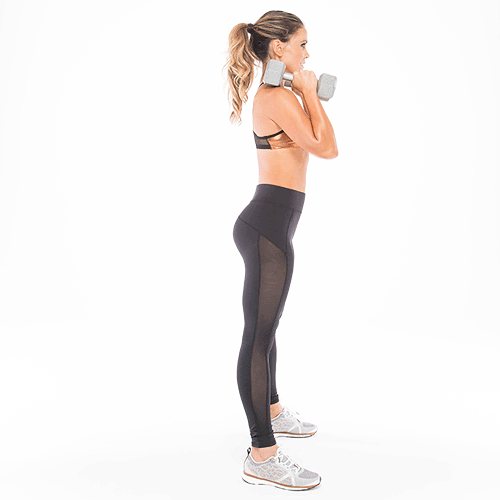
Lunges
The next exercise seems extremely simple, until you start doing it. Yes, yes, these are lunges with dumbbells, which, unlike the previous ones, are an isolating exercise. What does it mean? That's right, that exclusively the gluteal muscles and the back of the thigh are involved. The quadriceps, calves and back muscles serve exclusively as stabilizers.
How to do it correctly?
- Dumbbells are placed on the shoulders.
- One leg is placed as wide forward as possible.
- Next, bend your back
- Stretch towards your leg (make maximum emphasis).
- Make 2-3 springing movements.
- Change leg.
In total, this should be done 7-12 circles on each leg. The optimal weight for beginners is 5-8 kg each dumbbell.
Farmer's Walk with Long Steps
The farmer's walk with a wide stride is a more dynamic technique of the previous exercise. The main difference starts from the 5th point of movement. Namely, instead of just changing legs. From the lunge position, you need to move your back leg forward and lunge onto it. To visualize this movement easier, imagine that you are simply walking very wide, carrying bags of food in your hands. Although the position of the dumbbells plays an important role, since much larger equipment is used in the walk, the main recommendation would be to change their position. Those. can be held as during Plie.
Deadlift (forward bends with dumbbells)
This exercise is actively used in powerlifting, and even experienced athletes cannot always perform it correctly. But at the same time, of all of the above, it puts the greatest load on the back of the thigh, back muscles (responsible for posture), and most importantly, on the gluteal muscles.
How to perform a deadlift correctly?
- Dumbbells are picked up.
- Feet are placed shoulder width apart.
- The arch in the back remains
- The head looks ahead.
- Start moving downwards, keeping your back arched and your legs as straight as possible.
- At the lowest point, try to touch the floor (if stretching allows).
- Carefully rise from the lower phase, maintaining the deflection.
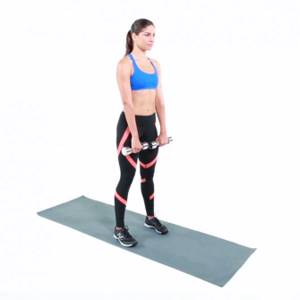
Types of Romanian deadlifts
There are situations when performing a standard Romanian deadlift with a barbell or dumbbells is not entirely suitable for training purposes and gaining muscle mass. There are several variations of the Romanian deadlift that can be included in training programs to accelerate muscle growth, work more muscle groups, or improve certain specific movements in various sports (bobsled, high jump, shot throw or hammer throw).
Romanian deadlift with kettlebells
Kettlebells are an excellent piece of equipment for home workouts, various fitness rooms and sports centers. Used to increase strength and train movements. Unlike the Romanian barbell deadlift, using a kettlebell (or dumbbells) helps eliminate asymmetrical (one-sided) muscle development and better strengthen your back, since each side can be worked independently of each other. More often used as an auxiliary exercise for training programs for gaining muscle mass.
Romanian single leg deadlift
The single leg variation is a unilateral exercise that improves balance, coordination, and the development of muscle groups and strength on each side individually. When performing a standard Romanian deadlift on two legs, it is possible to overlook the asymmetry of movement and disproportionate muscle development. Using each leg individually can correct muscle imbalances and prevent the possibility of injury.
The hamstrings (hamstrings) are one of the most commonly injured muscles in various sports.
Romanian deadlift with wide grip
By increasing the grip width of the barbell, we significantly increase the load on the upper back and trapezius. This specific movement is often used in the training of weightlifters. Used to strengthen the back and hips (for snatching). It also strengthens and prepares all parts of the spine for heavy back squats.
Tempo Romanian deadlift
These workouts can be done with any exercise to improve muscle development (strength or muscle mass). Attention is paid to weak muscle groups and neuromuscular coordination is improved. When performing tempo reps, the coach sets a specific “speed” at which the athlete should perform the movement. For example, lower the projectile for three seconds, and then suddenly, without a pause, lift it up. And so on for several repetitions.
Deadlift with dumbbells for girls
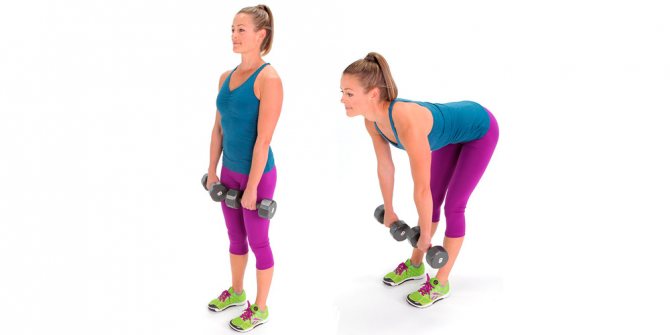
Many girls do not want to pump up the quadriceps muscle, as this increases the volume of the thighs. These girls can be advised to do deadlifts with dumbbells with almost straight legs, the so-called Romanian deadlifts. In addition, this option is more conducive to the development of the hamstrings and buttocks.
However, for those who do not have problems with the growth of the quadriceps muscle or who are not afraid of this situation, we can advise you not to change anything in your training and perform classic exercises with dumbbells and barbells.
Share link:
5 / 5 ( 6 votes)
Alternative variations of the Romanian deadlift
In situations where an athlete or coach wants to replace the Romanian deadlift with something due to lower back or spinal pain, fatigue or a desire to diversify the training program, the following exercises can be used: Good morning. This is a good alternative exercise to enhance the development of the lower back and glutes while limiting the stress on the hamstrings, which are less involved. Most often performed with a barbell or expander.
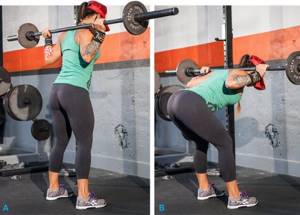


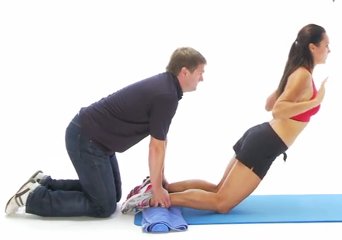
Good luck!

